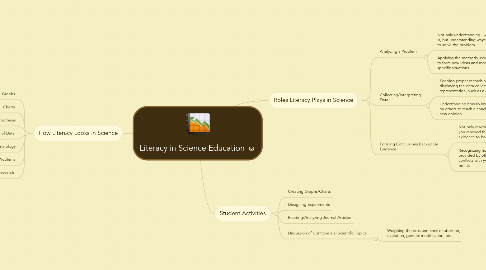
1. How Literacy Looks in Science
1.1. Graphs
1.2. Charts
1.3. Formation of a Hypothesis
1.4. Analysis of Data
1.5. Scientific Terminology
1.6. Investigation of Problems
1.7. Research
2. Roles Literacy Plays in Science
2.1. Analyzing a Problem
2.1.1. Not only understanding what the problem is, but understanding ways to figure out how to solve the problem
2.1.2. Applying the methods used to solve a problem to form new ideas and modify them to benefit specific situations
2.2. Collecting/Interpreting Data
2.2.1. Keeping proper records of observations and displaying the data collected in the proper representation, such as a chart or graph
2.2.2. Understanding how to interpret data presented by others to reach a conclusion or present a new opinion
2.3. Forming Conclusions Backed By Evidence
2.3.1. Not only reaching a conclusion, but citing why you reached that conclusion by providing evidence to back up your claims
2.3.2. Recognizing how to interpret evidence provided by others and how it reinforces or conflicts with your own evidence and view points
3. Student Activities
3.1. Creating Graphs/Charts
3.2. Designing Experiments
3.3. Reading/Analyzing Journal Articles
3.4. Discussion of Controversial Scientific Topics
3.4.1. Weighing the pros and cons of abortion, evolution, genetic modification, etc.
